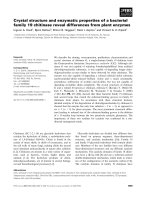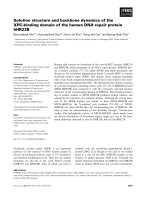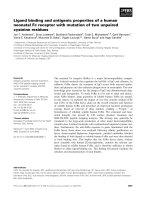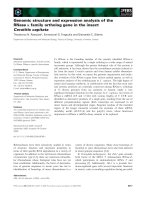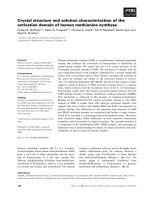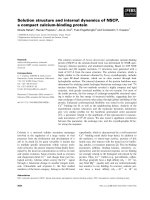Báo cáo hóa học: "Synthesis, structure and magnetic properties of b-MnO2 nanorods" pptx
Bạn đang xem bản rút gọn của tài liệu. Xem và tải ngay bản đầy đủ của tài liệu tại đây (349.64 KB, 6 trang )
NANO EXPRESS
Synthesis, structure and magnetic properties of b-MnO
2
nanorods
Hae Jin Kim Æ Jin Bae Lee Æ Young-Min Kim Æ
Myung-Hwa Jung Æ Z. Jaglicˇic´ Æ
P. Umek Æ J. Dolinsˇek
Published online: 11 January 2007
Ó to the authors 2007
Abstract We present synthesis, structure and
magnetic properties of structurally well-ordered sin-
gle-crystalline b-MnO
2
nanorods of 50–100 nm diame-
ter and several lm length. Thorough structural
characterization shows that the basic b-MnO
2
material
is covered by a thin surface layer (~2.5 nm) of a-Mn
2
O
3
phase with a reduced Mn valence that adds its own
magnetic signal to the total magnetization of the
b-MnO
2
nanorods. The relatively complicated temper-
ature-dependent magnetism of the nanorods can be
explained in terms of a superposition of bulk magnetic
properties of spatially segregated b-MnO
2
and a-Mn
2
O
3
constituent phases and the soft ferromagnetism of the
thin interface layer between these two phases.
Keywords Self-assembled nanorods Á Manganese
oxides Á Nanoscale magnetism
Introduction
The one-dimensional (1D) nanostructures in the form
of single-crystalline nanorods and nanowires have
attracted considerable interest because of their fasci-
nating application as interconnects and building blocks
in the nanoscale electronic, optoelectronic, and spin-
tronic devices [1–3]. Self-assembled quasi-1D nanorods
and nanowires, of typically several 10 nm in diameter
and several lm in length, are the smallest-dimension
structures that still allow efficient transport of elec-
trons. The nanorod- and nanowire form of the material
is considered to influence its physical properties, which
depart from the properties of their bulk phases due to
quantum effects related to the shape and size [4].
These effects represent a key factor to the ultimate
performance and application of the nano-sized
material.
Among several known materials that can be effi-
ciently prepared in the nanorod/nanowire form, man-
ganese oxides are of considerable importance in
technological applications such as catalysis, molecular
sieves and electrodes in rechargeable batteries, owing
to their outstanding structural flexibility combined with
novel chemical and physical properties [5]. Out of the
many polymorphic forms of manganese dioxide (a, b, c
and d), which involve different linking of the basic-unit
[MnO
6
] octahedra, a-MnO
2
nanowires have been
successfully synthesized by the acidification–hydrother-
mal method [6], whereas their subsequent treatment
with ethanol resulted in c-Mn
2
O
3
nanowire bundles.
Single-crystalline nanowires of a- and b-MnO
2
were
also prepared by selected-control hydrothermal
method [7] through the oxidation of Mn
2+
by S
2
O
8
2–
in the absence of catalysts or templates. A mixture of
H. J. Kim Á J. B. Lee
Energy Nano Material Team, Korea Basic Science Institute,
Daejeon 305-806, Korea
Y M. Kim
Division of Electron Microscopic Research, Korea Basic
Science Institute, Daejeon 305-806, Korea
M H. Jung
Quantum Material Research Team, Korea Basic Science
Institute, Daejeon 305-806, Korea
Z. Jaglic
ˇ
ic
´
Institute of Mathematics, Physics and Mechanics, Jadranska
19, Ljubljana 1000, Slovenia
P. Umek Á J. Dolins
ˇ
ek (&)
J. Stefan Institute, University of Ljubljana, Jamova 39,
Ljubljana 1000, Slovenia
e-mail:
Nanoscale Res Lett (2007) 2:81–86
DOI 10.1007/s11671-006-9034-4
123
single-crystalline cubic MnO and tetragonal Mn
3
O
4
nanowires was reported to be the final product of a
synthesis involving thermal evaporation of MnCl
2
under argon flow, and the nanowires showed unusual
magnetic properties [8] (i.e., the MnO nanowires
appeared ferromagnetic (FM) with T
C
= 12 K, though
bulk MnO is antiferromagnetic, AFM). In this paper
we present a hydrothermal method for the synthesis of
single-crystalline b-MnO
2
nanorods of excellent struc-
tural quality. We examine phase purity of the nanorods
and show that structurally well-ordered b-MnO
2
material is covered by a thin (~2.5 nm) surface layer
of a-Mn
2
O
3
phase with a reduced Mn valence state. We
also present magnetic properties of the b-MnO
2
nanorods and demonstrate the important role of the
surface layer in the rich temperature-dependent mag-
netism of this material.
Synthesis and characterization
The synthesis of the b-MnO
2
nanorods involved LiOH,
Mn(NO
3
)
2
· H
2
O and citric acid in a molar ratio
1.2:2:3.2 as the starting compounds, which were dis-
solved in water and the polymer poly(ethylene glycol)–
block–poly(propylene glycol)–(1100) was added. The
mixture was stirred in a magnetic field of 0.6 T strength
and then 50 ml of the solution was sealed in an 80 ml
teflon-lined autoclave. Hydrothermal synthesis was
performed at 100 °C for 48 h. The product was filtered
and rinsed with ethanol and dried at 100 °C for 12 h.
The polymer involved in the synthesis was fired out by
sintering at 500 °C in air for 2 h, which resulted in a
black solid as the final product. The role of the polymer
in the synthesis and the calcination of the polymeric
precursor at high temperature in air are described
elsewhere [9], whereas the chemistry of manganese
citrate complexes is explained in [10]. Scanning elec-
tron- (SEM) and transmission electron (TEM) micro-
scope images of the product material (Fig. 1) show its
morphology in the form of nanorods of dimensions
50–100 nm in diameter and 1–3 lm in length. SEM
image (Fig. 1a) also reveals that the nanorods were
synthesized with a high yield.
The x-ray spectra revealed the presence of two
phases (Fig. 2). The majority phase is the b-MnO
2
pyrolusite tetragonal structure with a = 4.40410 A
˚
,
c = 2.87650 A
˚
and space group P4
2
/mnm, whereas
the minority phase could be indexed to the a-Mn
2
O
3
bixbyte orthorhombic structure with a = 9.41610 A
˚
,
b = 9.42370 A
˚
, c = 9.40510 A
˚
and space group Pcab.
The relation of the two phases becomes evident from
the high-resolution (HRTEM) image of a single
nanorod (Fig. 3a) that was acquired using JEOL
JEM–ARM1300S high-voltage electron microscope
(operated at 1250 kV) with 1.2 A
˚
point–point resolu-
tion. It is observed that the interior of the selected
nanorod of 70 nm diameter consists of well-ordered
crystalline material, which is at the surface covered by
a 2.5-nm thin layer of another crystalline phase. The
electron diffraction patterns in Fig. 3a confirm that the
interior of the nanorod is the b-MnO
2
phase, whereas
the surface layer is the a-Mn
2
O
3
phase, in agreement
with the x-ray analysis of Fig. 2. The manganese in the
b-MnO
2
phase is in a Mn
4+
state, whereas its valence is
reduced to Mn
3+
in the a-Mn
2
O
3
surface layer, so that
the environment (very likely carbon coating during
firing procedure in air) obviously acts as a reducent to
Fig. 1 (a) SEM image of b-MnO
2
nanorods and (b) TEM image
of a single nanorod
123
82 Nanoscale Res Lett (2007) 2:81–86
the manganese in the last step of the synthesis
procedure. In Fig. 3b, atomic model of the b-MnO
2
phase (viewed along [1 1 0]) is superimposed on the
experimental HRTEM image, showing good matching
and confirming single-crystalline form of the nanorod.
The b-MnO
2
pyrolusite unit cell is also shown. Here we
mention that, despite the two-phase structure of the
nanorods, we shall keep labeling them by the generic
name ‘‘b-MnO
2
nanorods’’.
Magnetic properties
Magnetic measurements were performed by a Quan-
tum Design SQUID magnetometer equipped with a
5 T magnet and the measurements were conducted
between room temperature and 2 K. The M(H) curves
at 5, 55 and 110 K are displayed in Fig. 4a, showing
linear dependence of the magnetization on the mag-
netic field with a positive slope up to the highest field
5 T. The M(H) curve at 5 K exhibits small hysteresis
around H = 0 with a coercivity of 0.9 kOe (shown on
an expanded scale in Fig. 4b), demonstrating that the
magnetization at this temperature contains a FM
component, which is not observed at 55 K and higher.
The magnetization as a function of temperature, M(T),
in magnetic fields 50 Oe, 100 Oe, 1000 Oe, 1 T and 5 T
is displayed in Fig. 5a–e. Both zero-field-cooled (zfc)
and field-cooled (fc) runs are shown. Upon cooling
from room temperature, the M(T) curves first exhibit
two close maxima at temperatures 93 K and 80 K (best
observed on the 5 T and 1 T curves) that are indepen-
dent of the magnetic field, followed by a decrease of
the magnetization. Below the temperature of about
45 K the zfc–fc splitting starts to be observed. The
zfc–fc splitting is quite significantly affected by
the external magnetic field. In the low-field regime
Fig. 3 (Color online) (a) Atomic-resolved HRTEM image of a
b-MnO
2
nanorod, showing that the b-MnO
2
single-crystalline
material in the interior of the rod is covered by a 2.5-nm thin
surface layer of the a-Mn
2
O
3
phase (located between the two
arrows). The electron diffraction patterns of the two phases are
also shown. The right arrow points at the interface layer between
the b-MnO
2
and the a-Mn
2
O
3
phases. In (b), atomic model of the
b-MnO
2
phase (viewed along [1 1 0]) is superimposed on the
experimental HRTEM image of thickness 44 nm and defocus –
44 nm (Mn, green (large) circles; O, orange (small) circles). The
b-MnO
2
pyrolusite unit cell is also shown
Fig. 2 X-ray diffraction pattern of the b-MnO
2
nanorods. Two
sets of peaks are identified, one indexed to the b-MnO
2
pyrolusite phase and the other to the a-Mn
2
O
3
bixbyte phase
123
Nanoscale Res Lett (2007) 2:81–86 83
(below 1000 Oe), the zfc–fc splitting increases with the
field (at the lowest measuring temperature of 2 K, the
splitting in 1000 Oe is three times larger than in
50 Oe), whereas at higher fields, the splitting becomes
smaller again, showing tendency to vanish. The zfc–fc
curves also show features typical of magnetically
unstable systems: (i) the shapes of the zfc and fc curves
are strongly affected by the applied field and (ii) in the
highest field 5 T, the zfc curve even crosses the fc curve
and becomes higher above 30 K. This demonstrates
that, within the regime of the zfc–fc splitting, magnetic
ordering in the b-MnO
2
nanorods is soft with internal
fields of comparable magnitude to the externally
applied field. In order to check whether the zfc–fc
magnetization splitting is related to a magnetic phase
transition, we performed ac magnetization measure-
ments at frequencies 1, 10, 100 and 1000 Hz (Fig. 5f).
We observe a frequency-independent peak at 40.5 K,
indicating a thermodynamic FM-type phase transition
with a critical slowing-down of the spin fluctuations.
Discussion
The rich structure of the M(T) curves can be analyzed
by considering magnetic properties of the b-MnO
2
and
a-Mn
2
O
3
bulk phases. Bulk b-MnO
2
undergoes a
transition to an incommensurately-modulated helical
AFM state at T
N
% 92.5 K that exhibits both long- and
short-range magnetic orders [11, 12]. Its magnetic
susceptibility exhibits well-developed peak at T
N
[12].
Since b-MnO
2
is also the dominant phase of our
investigated nanorods, it is straightforward to attribute
the peak in the magnetization at 93 K in Fig. 5 to the
same magnetic phase transition. The nanodimensions
of the material obviously do not destroy the AFM state
of the bulk phase. Regarding magnetic ordering of the
a-Mn
2
O
3
bulk phase, a neutron study has shown [13]
that majority of the magnetic peaks disappear above
T
N
~ 80 K (a similar transition temperature T
N
~ 79 –
80 K was reported also from heat capacity measure-
ments [14] and magnetic susceptibility and Mo
¨
ssbauer
effect [15]onMn
2–x
Fe
x
O
3
). According to the neutron
results [13], magnetic order in the bulk a-Mn
2
O
3
can be
described by a set of six collinear AFM spin arrange-
ments on a cubic lattice. The peak at 80 K in the M(T)
of the investigated b-MnO
2
nanorods can be thus
associated with the magnetic ordering within the
a-Mn
2
O
3
surface layer. Therefore, the two maxima in
the M(T) of the nanorods at 93 and 80 K can be given a
simple explanation by invoking magnetic properties of
the bulk b-MnO
2
and a-Mn
2
O
3
phases (in Fig. 5a, the
temperatures of the magnetization maxima expected
for these two bulk phases are indicated by dashed
lines). A surprising effect is the low-temperature FM
magnetization component that cannot be attributed to
any of these two phases. The ac magnetization peak at
40.5 K suggests that additional manganese-oxide
phases could be present in the investigated b-MnO
2
nanorods. The Mn
2
O
3
material has two structural
isomers: a-Mn
2
O
3
is the thermally stable mineral
bixbyte, whereas c-Mn
2
O
3
is thermally less stable and
does not occur naturally. On heating up to 600–800 °C
in air, c-Mn
2
O
3
transforms into the stable a-Mn
2
O
3
.
Recent magnetic measurements on c-Mn
2
O
3
nanopar-
ticles [16] have shown that the nanoparticle-material
exhibits ferrimagnetism below T
C
= 39 K with high
coercivity (~8 kOe at 5 K). Similarly, the Mn
3
O
4
bulk
material (that is isostructural with c-Mn
2
O
3
) was
reported [17] to undergo a transition to a ferrimagnetic
state at T
C
= 42 K. In another study [18], Mn
3
O
4
Fig. 4 (a) Magnetization as a function of the magnetic field of
the b-MnO
2
nanorods at 5, 55 and 110 K. (b) Expanded portions
of the M(H) curves, showing hysteresis at 5 K
123
84 Nanoscale Res Lett (2007) 2:81–86
nanoparticles of varying diameters between 6 and
15 nm showed size-dependent T
C
between 36 and
41 K. These FM transition temperatures are remark-
ably close to that observed in our b-MnO
2
nanorods.
However, all the peaks in the x-ray spectrum of the
nanorods in Fig. 2 can be indexed to the b-MnO
2
and
a-Mn
2
O
3
phases and do not reveal the presence of any
additional phase within the sensitivity of the XRD
experiment (about 2% volume). Careful comparison
with the x-ray spectra of the c-Mn
2
O
3
nanoparticles
(see Fig. 2 of [16]) and the Mn
3
O
4
nanowires (see
Fig. 2 of [8]) shows that there are no traces of these
two phases in the x-ray spectrum of Fig. 2. The most
probable origin of the FM component in the magne-
tization of the b-MnO
2
nanorods is then magnetic
ordering within the mismatch layer at the interface
between the b-MnO
2
interior phase and the a-Mn
2
O
3
surface layer that can be identified in Fig. 3a
unambiguously as two columns of white spots (located
at the position of the right arrow). The physics and
chemistry of this thin mismatch layer (of thickness
about two atomic monolayers) cannot be discussed
easily, but there exists reasonable possibility that
FM correlations, analogous to those in Mn
3
O
4
and
c-Mn
2
O
3
phases, could develop between the Mn spins
within the interface layer. The small magnetization
coercivitiy of 0.9 kOe at 5 K of the b-MnO
2
nanorods
(Fig. 4b) does not, however, support direct analogy
with neither the c-Mn
2
O
3
nanoparticle-material nor
the Mn
3
O
4
, which are both characterized by high
coercivities of the order 8 kOe [16, 17, 19]. The FM
spin structure within the investigated b-MnO
2
nano-
rods is obviously much softer.
The relatively complicated temperature-dependent
magnetism of the investigated b-MnO
2
nanorods can,
therefore, be explained in terms of a superposition of
Fig. 5 Magnetization of the
b-MnO
2
nanorods as a
function of temperature in
magnetic fields (a)5T,
(b) 1 T, (c) 1000 Oe, (d)
100 Oe and (e) 50 Oe. Both
zero-field-cooled (zfc) and
field-cooled (fc) runs are
shown. Note that the spans of
the vertical scale in panels are
different. The temperatures
of the magnetization maxima
expected for the bulk phases
of b-MnO
2
(T
N
~ 92.5 K)
and a-Mn
2
O
3
(T
N
~ 80 K)
are indicated in panel (a) by
dashed lines. (f)ac
susceptibility v’ in the field
of amplitude 6.5 Oe as a
function of temperature at
frequencies 1, 10, 100 and
1000 Hz
123
Nanoscale Res Lett (2007) 2:81–86 85
magnetic properties of the spatially segregated
constituent manganese-oxide phases b-MnO
2
and
a-Mn
2
O
3
, whereas the FM component is most likely
associated with the not-well-understood magnetism of
the mismatch layer at the interface between these two
phases. The interior b-MnO
2
phase and the a-Mn
2
O
3
thin surface layer both exhibit AFM properties anal-
ogous to their bulk phases (the temperatures of the
maxima in the T-dependent magnetization of the
nanorods and the bulk materials match well) despite
the nanodimensions of the rods. These results show
how important it is to make a thorough structural
characterization of the material on the atomic-resolu-
tion scale before entering the discussion on the
influence of nanodimensions on the physical properties
of the material. We should also like to mention that
similar structure of a thin surface layer of another
phase that covers the basic b-MnO
2
material was
observed (see Fig. 3dof[7]), though not discussed, also
for the b-MnO
2
nanorods produced by the selected-
control hydrothermal synthesis [7], so that this kind of
structure of the b-MnO
2
nanorods seems to appear
quite commonly.
Conclusions
To summarize, we presented a hydrothermal method
for the synthesis of structurally well-ordered single-
crystalline b-MnO
2
nanorods. We show that the basic
b-MnO
2
material is covered by a thin surface layer of
the a-Mn
2
O
3
phase with a reduced Mn valence that
adds its own magnetic signal to the total magnetization.
The nanodimensions of the investigated nanorods do
not appear to affect significantly their magnetic
response, which can be explained as a superposition
of bulk magnetic properties of the spatially segregated
constituent manganese-oxide phases and the magne-
tism of the thin interface between them. This result
prompts for further investigations of the magnetism of
nano-sized materials in order to prove/disprove the
often-claimed exceptionality of magnetism on the
nanometric scale.
Acknowledgment This work was supported by the Frontier
Research Laboratory Program at the Korea Basic Science
Institute.
References
1. C. Dekker, Phys. Today 52, 22 (1999)
2. X. Duan, Y. Huang, Y. Cui, J. Wang, C.M. Lieber, Nature
409, 66 (2001)
3. Y. Xia, P. Yang, Y. Sun, Y. Wu, B. Mayers, B. Gates, Y. Yin,
F. Kim, H. Yan, Adv. Mater. 15, 353 (2003)
4. C.N.R. Rao, F.L. Deepak, G. Gundiah, A. Govindaraj, Prog.
Solid Chem. 31, 5 (2003)
5. M.M. Thackeray, Prog. Solid State Chem. 25, 1 (1997)
6. X. Chen, X. Li, Y. Jiang, C. Shi, X. Li, Solid State Commun.
136, 94 (2005)
7. X. Wang, Y. Li, J. Am. Chem. Soc. 124, 2880 (2002)
8. C.W. Na, D.S. Han, D.S. Kim, J. Park, Y.T. Jeon, G. Lee,
M H. Jung, Appl. Phys. Lett. 87, 142504 (2005)
9. W. Liu, G.C. Farrington, F. Chaput, B. Dunn, J. Electro-
chem. Soc. 143, 879 (1996)
10. M. Matzapetakis, N. Karligiano, A. Bino, M. Dakanali,
C.P. Raptopoulou, V. Tangoulis, A. Terzis, J. Giapintzakis,
A. Salifoglou, Inorg. Chem., 39, 4044 (2000)
11. M. Regulski, R. Przeniosło, I. Sosnowska, J U. Hoffmann,
J. Phys. Soc. Japan 73, 3444 (2004)
12. N. Ohama, Y. Hamaguchi, J. Phys. Soc. Japan 30, 1311
(1971)
13. M. Regulski, R. Przeniosło, I. Sosnowska, D. Hohlwein,
R. Schneider, J. Alloys Compd. 362, 236 (2004)
14. E.G. King, J. Am. Chem. Soc. 76, 3289 (1954)
15. R.W. Grant, S. Geller, J.A. Cape, G.P. Espinoza, Phys. Rev.
175, 686 (1968)
16. S.H. Kim, B.J. Choi, G.H. Lee, S.J. Oh, B. Kim, H.C. Choi,
J. Park, Y. Chang, J. Korean Phys. Soc. 46, 941 (2005)
17. B. Boucher, R. Buhl, M. Perrin, J. Appl. Phys. 42, 1615
(1971)
18. W.S. Seo, H.H. Jo, K. Lee, B. Kim, S.J. Oh, J.T. Park,
Angew. Chem. 43, 1115 (2004)
19. I. S. Jacobs, Chem. Solids 11, 1 (1959)
123
86 Nanoscale Res Lett (2007) 2:81–86




